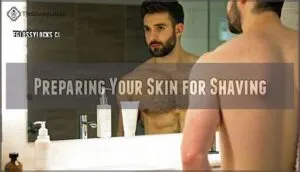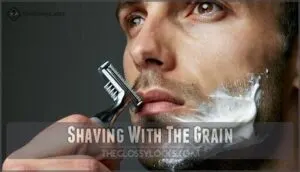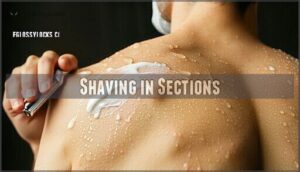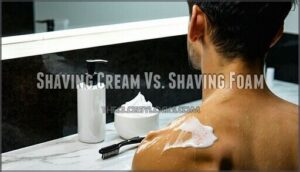This site is supported by our readers. We may earn a commission, at no cost to you, if you purchase through links.
 To apply shaving cream for back hair effectively, start by trimming longer hair to prevent razor clogs. Take a warm shower to soften the hair and open your pores, then apply a generous, even layer of quality shaving cream across your entire back.
To apply shaving cream for back hair effectively, start by trimming longer hair to prevent razor clogs. Take a warm shower to soften the hair and open your pores, then apply a generous, even layer of quality shaving cream across your entire back.
You’ll want to use circular motions to work the cream into a rich lather that covers every area you plan to shave. Consider using a long-handled applicator or asking someone for help reaching those tricky spots between your shoulder blades.
The key is ensuring complete coverage with enough product to create a protective barrier between your skin and the razor. Proper application sets the foundation for mastering the actual shaving technique and avoiding common pitfalls.
Table Of Contents
- Key Takeaways
- Choosing The Right Shaving Cream
- Preparing Your Skin for Shaving
- Applying Shaving Cream Correctly
- Shaving Techniques for Your Back
- Tips for Sensitive Areas
- Shaving Cream Vs. Shaving Foam
- Common Shaving Mistakes to Avoid
- After-Shave Care for Your Back
- Maintaining Your Shaving Routine
- Troubleshooting Common Issues
- Frequently Asked Questions (FAQs)
- How do I Shave my Back?
- How do you shave with a shaving cream?
- How do you use a shaving cream on your back?
- Should you shave your back hair?
- Do you need shaving cream & a razor?
- How do you shave your back if you have ingrown hairs?
- How do I shave my back hair?
- Do you need shaving cream to shave your back?
- How to apply shaving cream on back?
- How should I shave my back hair?
- Conclusion
Key Takeaways
- Choose the right shaving cream – You’ll want a thick, moisturizing formula with ingredients like glycerin and aloe vera that’s specifically designed for sensitive skin and coarse body hair.
- Prepare your skin properly – You should trim long hair to ¼ inch, take a warm shower to soften hair follicles, and exfoliate gently before applying any shaving cream.
- Apply cream systematically – You need to use a long-handled applicator or back brush to spread a thick, even layer across your entire back, working in sections from shoulders down.
- Don’t skip aftercare – You must moisturize immediately after shaving and exfoliate regularly between shaves to prevent ingrown hairs and razor burn.
Choosing The Right Shaving Cream
Selecting the right shaving cream makes all the difference between a smooth back shave and an irritated mess that’ll have you reaching for aloe vera.
You’ll want a cream that provides excellent lubrication while being gentle enough for the sensitive skin on your back.
Types of Shaving Cream for Back Hair
When choosing shaving cream for your back’s unique terrain, you’ll find four main cream types that tackle thick body hair differently.
Dense creams provide superior lubrication for coarse hair, while gels offer clear visibility for precise shaving.
- Traditional creams – Rich, moisturizing formulas with glycerin for sensitive skin protection
- Gel-based options – Enhanced glide properties perfect for thicker back hair coverage
- Foam varieties – Quick-spreading coverage using propellants for large surface areas
- Hypoallergenic formulas – Fragrance-free, gentle ingredients preventing irritation and razor burn
Understanding various shaving cream types is essential for making an informed decision.
Ingredients to Look for in Shaving Cream
Understanding your cream’s ingredients helps you pick the right product for your back.
Look for moisturizing properties like glycerin and aloe vera to prevent dryness. Natural ingredients such as chamomile and tea tree oil act as skin soothers, reducing irritation.
Here’s what matters most:
| Ingredient Type | Key Components | Benefits |
|---|---|---|
| Moisturizing Agents | Glycerin, Shea Butter, Coconut Oil | Hydrate skin, prevent razor burn |
| Natural Ingredients | Aloe Vera, Chamomile, Jojoba Oil | Soothe inflammation, calm irritation |
| Lubricating Compounds | Stearic Acid, Dimethicone | Improve blade glide, reduce friction |
| Skin Soothers | Allantoin, Bisabolol | Speed recovery, minimize redness |
| Antibacterial Agents | Tea Tree Oil, Witch Hazel | Prevent infection, maintain clear pores |
Choose fragrance-free options to avoid allergic reactions.
Considerations for Sensitive Skin
When dealing with sensitive skin, you’ll want to avoid harsh chemicals that turn your back into a battlefield. Choose fragrance-free and hypoallergenic shaving creams with gentle ingredients.
Don’t let harsh chemicals turn your back into a battlefield—choose gentle, fragrance-free formulas instead
Here are four essential considerations for sensitive skin types:
- Gentle Products – Select alcohol-free formulas with natural moisturizers
- Soothing Techniques – Apply cream with light, circular motions
- Irritation Prevention – Test products on small areas first
- Sensitive Areas – Use extra care around shoulders and spine
Back hair shaving for sensitive skin requires patience and the right shaving cream application techniques. Understanding sensitive skin needs is vital for selecting the best products and techniques to avoid irritation.
How to Read Shaving Cream Labels
Reading shaving cream labels prevents skin disasters.
Look for label ingredients like glycerin and aloe for sensitive skin. Check allergy warnings and avoid harsh sulfates.
Fragrance options matter—unscented works best shaving cream for backs. Spot skin alerts about reactions.
Check expiration dates because expired cream won’t protect your skin properly during shaving cream application.
Preparing Your Skin for Shaving
Proper skin preparation sets the foundation for a smooth, irritation-free back shave that’ll make you wonder why you waited so long to tackle this grooming challenge.
You’ll need to cleanse, trim, soften, and prime your skin before applying any shaving cream to achieve professional-quality results at home.
Exfoliating and Cleansing Your Back
Proper skin prep sets you up for success with back hair removal. Clean your back with a gentle back cleanser to remove oils and sweat that interfere with shaving cream adhesion.
- Use a gentle loofah or back scrub 1-2 times weekly
- Apply warm water to soften dead skin cells
- Massage gently in circular motions for skin exfoliation
- Rinse thoroughly before applying your shaving cream
Trimming Long Hair Before Shaving
Long back hair removal starts with proper hair trimming.
Use electric clippers to cut hair down to ¼ inch – this hair length creates perfect shave readiness.
Your trimming tools make back preparation smoother by preventing razor clogs and reducing irritation.
Smart trimming before applying shaving cream sets you up for successful long hair shaving using proper shaving techniques.
Softening Hair With Warm Water
After trimming, warm water becomes your best friend for hair softening. Jump in the shower and let the heat do the work.
This skin preparation step makes stubborn back hair pliable, creating the perfect canvas for shaving cream application.
The soothing rinse opens hair follicles and provides gentle exfoliation, ensuring smooth shaving techniques ahead.
Applying a Pre-Shave Oil or Balm
Once you’ve softened your hair with warm water, apply pre shave oils or balm for enhanced skin preparation.
These products reduce friction and prevent irritation during back hair shaving. Choose coconut or jojoba preshave oil, or select moisturizing balm types with soothing ingredients.
Apply a thin layer using proper oil application techniques, allowing complete absorption before applying shaving cream for ideal results.
Applying Shaving Cream Correctly
Now you’re ready to apply shaving cream correctly to guarantee a smooth, irritation-free shave.
Getting the right coverage and consistency makes all the difference between a comfortable shave and razor burn that’ll have you regretting the whole process, which is why correctly applying shaving cream is crucial.
How to Lather Shaving Cream
Creating proper lather transforms your shaving cream application from messy to masterful.
Start with quality shaving cream and follow these lathering techniques:
- Use a synthetic brush with warm water for 40% more foam volume
- Apply a 2:1 cream-to-water ratio for ideal density
- Work in circular motions for 90 seconds minimum
- Add water gradually to prevent foam breakdown
This complete shaving prep guarantees complete coverage across your back’s surface area, making it a masterful approach to shaving.
Applying a Thick, Even Layer
With your lathered cream ready, it’s time to apply a thick, even layer across your back.
Proper cream application sets the foundation for effective shaving techniques and smooth results.
Coverage Tips Application Tools Shaving Cream Consistency
Focus on layer thickness – too thin won’t protect your skin, too thick wastes product.
Start at your shoulders and work downward using steady pressure.
This shaving cream guide guarantees complete coverage without missing spots that could cause irritation during back exfoliation.
Covering All Areas of The Back
Once you’ve achieved that thick lather, focus on back coverage by systematically working across your entire back surface.
Don’t miss those hard areas around your shoulder blades and lower spine where back hair tends to hide.
Use your razor extension to reach every spot, ensuring complete skin preparation. To prevent irritation, consider gentle pressure techniques while shaving.
Proper shaving technique means covering all territory before you start shaving back hair with consistent shaving cream application.
Using a Shaving Cream Applicator
With your back properly covered, you’ll need a reliable applicator for even shaving cream distribution.
This tool helps you reach difficult areas that would otherwise challenge your flexibility.
Here’s how to master applicator use:
- Select quality applicators: Choose wands with soft silicone or foam pads that won’t scratch your skin
- Apply consistent pressure: Use gentle, sweeping motions to guarantee even application across all body hair shaving areas
- Target hard-to-reach spots: Focus on spine and shoulder blade regions where manual application fails
- Maintain your tools: Clean applicators thoroughly after each use to prevent bacteria buildup and extend their lifespan
Quality wand materials make all the difference when shaving back hair, turning an awkward process into something manageable.
Consider exploring different shaving cream applicators for superior results.
Shaving Techniques for Your Back
Now that you’ve prepared your back and applied shaving cream properly, it’s time to master the actual shaving technique.
The key to success lies in using the right movements, proper tools, and a systematic approach that prevents irritation while ensuring complete coverage.
Shaving With The Grain
Something magical happens when you master Hair Growth Direction—suddenly, back hair shaving transforms from a battle into a breeze. Following your natural Grain Mapping reduces razor drag and delivers superior Smoothness Level.
Most folks discover their back hair grows downward, making top-to-bottom strokes the golden rule for shaving techniques.
| Hair Growth Pattern | Ideal Angle |
|---|---|
| Downward growth | Vertical strokes (top to bottom) |
| Diagonal growth | Follow natural slant direction |
| Swirled areas | Map carefully, shave in sections |
| Mixed patterns | Adjust technique per zone |
Proper shaving cream application paired with grain-following strokes minimizes Reduced Irritation while maximizing comfort during your grooming routine.
Using a Back Razor or Extension Handle
Ready to tackle those tricky spots? Using a back razor or extension handle really helps you remove back hair with less hassle.
Keep your razor extender at a 30° angle for smooth gliding and fewer nicks. Focus on handle grips for control, and don’t forget blade maintenance.
Mirror placement is key—no one wants a patchy finish!
- Razor angles matter
- Handle grips prevent slips
- Regular blade maintenance
Shaving in Sections
Ever wonder how pros tackle shaving back hair?
Divide your back into sections—upper, middle, and lower—for steady control and easier reach.
Use a mirror for accuracy and watch your Section Order.
Reapply shaving cream as you go, especially around tricky spots like the spine.
Don’t forget to reach the sides; these back shaving tips help you remove back hair smoothly.
Avoiding Ingrown Hairs and Razor Burn
After you’ve tackled each section, focus on preventing ingrown hairs and razor burn.
Start with exfoliation methods—use a scrub or exfoliating glove before shaving back hair.
Choose a sharp razor and always shave in the direction of hair growth.
Hydration importance can’t be overstated; use plenty of shaving cream.
Many prefer alcohol-free aftershaves to avoid skin irritation.
Stick to a steady aftercare routine to keep skin calm and prevent razor burn.
Tips for Sensitive Areas
You’ll want to treat sensitive areas like the neck and shoulders with extra care when applying shaving cream.
A gentle touch helps prevent razor burn and ingrown hairs, making the process smoother and more comfortable.
Shaving Around The Neck and Shoulders
When you move from broad strokes to the neck and shoulders, pay close attention to Neck Shaving Angles and Shoulder Blade Contours.
These Skin Sensitivity Zones need a lighter touch and steady hands.
Don’t rush—reach and flexibility matter.
Use shaving cream generously and avoid pressing too hard.
Post-Shave Irritation loves careless moves, so take it slow and Glide, don’t press.
- Use mirrors for tricky spots
- Keep skin taut
- Moisturize after shaving
Avoiding Razor Burn and Ingrown Hairs
Someone who’s tired of razor burn and ingrown hairs knows it’s all about smart back shaving tips.
Keep your blade sharp for every session—dull razors are trouble.
Always shave in the direction of hair growth, not against it.
Exfoliate your back weekly to prevent trapped hairs.
Finish with post-shave care and hydration—your skin will thank you.
Using a Gentle Touch
If you want to avoid irritation while shaving your back, focus on using a gentle touch.
Let the razor glide with light pressure and slow strokes. Pay attention to skin sensitivity and check your razor sharpness.
Here are quick back shaving tips:
- Use light pressure
- Take slow strokes
- Check razor sharpness
- Watch for skin sensitivity
- Avoiding irritation
Applying a Soothing Balm After Shaving
Smooth moves don’t end with the razor—aftershave care is key. Once you’ve finished your shaving back techniques, grab a balm packed with soothing Balm Ingredients.
The right Application Timing helps lock in Skin Hydration and boost Irritation Relief. Aftershave balms with aloe vera benefits are particularly effective.
Use a back lotion applicator if needed. For best results:
- Pick a fragrance-free Product Selection
- Massage a thin layer gently
- Reapply as needed for comfort
- Avoid heavy formulas to keep pores clear
Shaving Cream Vs. Shaving Foam
When choosing between shaving cream and shaving foam for your back, you’ll notice some key differences in texture and coverage.
Picking the right one makes the process smoother and helps reduce irritation, especially in hard-to-reach spots, which is crucial for a comfortable shave with minimal irritation.
Differences in Texture and Consistency
After tackling sensitive areas, let’s talk about texture. When you’re choosing between shaving cream and foam for back shaving, think about Cream Thickness and Foam Volume.
Shaving cream offers a rich, lotion-like feel that hugs every hair, while foam is light and airy.
Here’s a quick comparison:
| Feature | Shaving Cream | Shaving Foam |
|---|---|---|
| Gel Density | High | Low |
| Lather Quality | Smooth | Airy |
| Oil Viscosity | Soothing | Neutral |
The key differences between shaving cream and foam can be seen in their Gel Density, Lather Quality, and Oil Viscosity, which affect the overall shaving experience, making Soothing properties an important consideration.
Which is Better for Back Hair?
In the context of back shaving, Cream vs. Foam isn’t just a toss-up—shaving cream wins by a landslide.
Its dense texture softens coarse back hair, giving you smoother results and less irritation.
Shaving cream also hydrates skin, reducing Shaving Downsides like razor burn.
Check out the quick comparison:
| Cream vs. Foam | Shaving Downsides |
|---|---|
| Softer, smoother shave | More irritation with foam |
| Better hydration | Dryness risk with foam |
| Reduces ingrown hairs | Patchy results with foam |
| Longer-lasting comfort | More nicks and cuts |
| Easier to apply evenly | Missed spots common |
This comparison highlights the benefits of using shaving cream, including a softer, smoother shave and better hydration, making it the preferred choice for back shaving.
Personal Preference
A little secret: choosing between shaving cream and foam for back hair is all about personal care and comfort.
Your skin type, hair texture, and shave frequency matter.
Some prefer a smooth finish, others want speed.
Test both and trust your gut.
Here’s a quick breakdown:
| Factor | Cream |
|---|---|
| Skin Type | Sensitive |
| Hair Texture | Thick |
| Shave Frequency | Weekly |
| Back Care | Hydrating |
| Smooth Finish | Superior |
This approach allows you to find what works best for your skin type and hair texture, ensuring a smooth finish with the right choice between shaving cream and foam.
Common Shaving Mistakes to Avoid
You might think shaving your back is simple, but common mistakes can lead to irritation or missed spots.
Knowing what to avoid helps you achieve a smoother, safer shave every time.
Shaving Too Closely or With Too Much Pressure
After weighing the pros and cons of shaving cream versus foam, let’s talk about pressure control.
Pressing your razor too hard or chasing an ultra-close shave is a fast track to razor burn, skin irritation, and ingrown hairs.
Use gentle strokes, let the shaving cream do its job, and focus on smart shaving techniques for men—especially if you’ve got sensitive skin.
Not Rinsing The Razor Properly
One big mistake you’ll want to dodge during the back hair shaving process isn’t rinsing your razor properly.
Hair accumulation and clogged blades mess with razor maintenance and can cause razor burn.
A dirty razor also invites bacterial growth. Practice good razor cleaning after every few strokes—fresh blades mean smoother shaving techniques for men and fewer skin troubles.
Not Moisturizing After Shaving
Skipping moisturizer after shaving back hair is like forgetting sunscreen on a beach day—your skin’s bound to protest.
Dry Skin Issues, irritation, and razor burn creep in fast without proper Post Shave Care. Make moisturizing a non-negotiable step in your After Shave Routine to lock in Skin Hydration and keep things smooth.
Choose a moisturizer matched to your skin type for the best Moisturizer Benefits. This simple shaving aftercare keeps skin healthy, happy, and helps prevent those pesky ingrown hairs.
Skin Type Moisturizer Type Benefits
Shaving Over The Same Spot Multiple Times
Don’t go over the same patch of back hair more than needed.
It’s tempting to chase that last stubborn strand, but repeating strokes increases razor pressure and skin irritation.
Stick to a steady shave technique—one clean pass with shaving cream does the trick.
Overdoing it leads to razor burn, uneven hair regrowth, and bumps.
Smart shaving techniques mean smoother skin and less hassle.
After-Shave Care for Your Back
After shaving your back, you’ll want to keep your skin calm and healthy to prevent irritation.
Proper after-shave care helps you avoid razor burn, ingrown hairs, and dryness, so you don’t have to spend the day scratching like a bear.
Applying a Moisturizer or Aftershave Balm
Treat your skin to some TLC after shaving your back. Slather on a moisturizer or aftershave balm to boost Skin Hydration and lock in comfort.
Choose Soothing Products with aloe, vitamin E, or tea tree oil for high-quality Moisturizer Benefits and Balm Application. Using Aftershave Balm products can help with this process.
Here’s what you need:
- Use fragrance-free options
- Apply while skin’s damp
- Massage gently
- Focus on dry spots to achieve optimal Skin Hydration and Soothing effects.
Soothing Razor Burn and Ingrown Hairs
Once you’ve applied moisturizer or aftershave balm, it’s time to tackle razor burn and ingrown hairs for true hair relief.
Here’s your skin-soothing toolkit:
- Use cold compresses to calm irritation.
- Apply aloe vera gel for quick soothing.
- Dab tea tree oil to reduce redness.
- Choose after shave balms with anti-inflammatory ingredients.
Exfoliating to Prevent Ingrown Hairs
Now that you’ve tackled razor burn, let’s focus on Dead Skin Removal through proper Exfoliation Techniques. Regular exfoliation is your best defense against Ingrown Hair Prevention.
Skin Smoothening happens when you remove dead cells that trap hair follicles. Hair Follicle Care requires consistent attention.
Use gentle scrubs or chemical exfoliants containing AHAs/BHAs twice weekly for ideal skin care results.
| Exfoliating Tools | Scrubbing Frequency |
|---|---|
| Loofah or gentle scrub | 1-2 times a week |
| Chemical exfoliant (AHAs/BHAs) | 1-2 times a week |
| Exfoliating gloves | 1 time a week |
| DIY sugar or salt scrubs | 1 time a week |
Trimming Hair to Prevent Regrowth
Regular hair trimming maintains your smooth back between shaving sessions.
Trim back hair every 2-4 weeks using clippers to keep hair length manageable—about ¼ inch works best.
This regrowth prevention strategy makes future back shaving easier while your shaving cream spreads more evenly.
Following your natural regrowth cycle prevents unruly hair from complicating your back shaving techniques.
Maintaining Your Shaving Routine
A consistent back shaving routine keeps your skin smooth and prevents ingrown hairs from ruining your progress.
You’ll need to establish a schedule, maintain your tools properly, and adjust your technique as your skin adapts to regular shaving.
You’ll also need to maintain your tools properly.
How Often to Shave Your Back
Your shave frequency depends on hair regrowth patterns and skin type.
Most people should shave their back every 1-2 weeks for ideal results.
Those with sensitive skin benefit from longer intervals, while faster growers might need weekly back maintenance.
Monitor your skin’s response and adjust shave timing accordingly for consistent smooth skin.
Storing and Cleaning Your Razor
How do you maintain your razor’s peak performance between shaving sessions? Proper razor storage and blade cleaning prevent costly replacements and razor burn.
After each shaving routine, rinse thoroughly and dry completely to avoid rust buildup. Store in a moisture-free environment for ideal blade maintenance.
Essential razor maintenance steps include:
- Rinse blade under hot water to remove shaving cream residue
- Apply cleaning solutions or rubbing alcohol for handle sanitizing
- Dry with clean towel to prevent water damage
- Store upright in ventilated area away from humidity
Replacing Your Razor Blade
Blade-dulling happens faster than you’d think, especially with coarse back hair.
Replace your razor blade every 5-7 shaves to maintain blade sharpness and prevent razor burns.
Dull blades require more pressure, increasing irritation risk.
Store razors in dry areas for rust prevention.
Quality blade replacement guarantees effective shaving techniques and superior razor maintenance for smooth results.
Adjusting Your Shaving Technique
Fine-tuning your shaving technique becomes second nature with practice. Adjust your razor grip for better control, experiment with different shaving angles, and modify blade pressure to prevent razor burns.
Master proper skin tension and shave strokes while ensuring adequate shaving cream coverage throughout your back hair removal routine. Understanding proper shaving techniques is essential for achieving smooth results.
- Feel the confidence of mastering your personal grooming routine
- Experience the satisfaction of achieving salon-quality results at home
- Enjoy the freedom of smooth, irritation-free skin year-round
- Embrace the pride that comes with perfecting your shaving technique
- Celebrate each successful shave as a victory in your shaving guide journey
Troubleshooting Common Issues
Even experienced shavers encounter occasional problems when removing back hair.
You’ll quickly resolve common issues like ingrown hairs, razor burn, cuts, and skin reactions by understanding their causes and applying the right solutions to achieve smooth skin and prevent razor burn.
Ingrown Hairs and Razor Burn
Even well-maintained shaving routines can trigger skin irritation and razor bumps.
When hair follicles become inflamed or trapped beneath the surface, you’ll need targeted burn relief strategies to restore comfort.
Here’s your ingrown prevention action plan:
- Apply gentle exfoliation – Use chemical exfoliants containing salicylic acid to clear blocked hair follicles without aggressive scrubbing
- Choose anti-inflammatory products – Select aftershave balms with aloe vera or tea tree oil for immediate burn relief
- Modify your shaving techniques for women – Always shave with the grain using quality shaving cream designed for sensitive skin
- Avoid restrictive clothing – Loose-fitting garments prevent friction that worsens ingrown hairs and prolongs healing time
Cuts and Nicks
Cuts and nicks happen when you rush or use dull blades.
Bleeding Control requires immediate Wound Care: apply gentle pressure with clean cloth until bleeding stops.
Sharp razors and proper shaving cream application prevent most Skin Tears.
For Nick Prevention, use light pressure and fresh blades.
Never shave over cuts twice—it worsens shaving irritations and creates more nicks.
Skin Irritation and Allergic Reactions
When allergic reactions strike your back after shaving, you’ll need swift action to prevent escalation.
Skin irritation and redness treatment require identifying irritation causes through proper skin care and allergy tests for sensitive skin.
- Choose fragrance-free shaving cream specifically formulated for sensitive skin
- Apply cold compresses to reduce inflammation and soothe razor burn immediately
- Use hydrocortisone cream or aloe vera gel for natural redness treatment
- Avoid shaving until irritation subsides to prevent worsening ingrown hairs
Frequently Asked Questions (FAQs)
How do I Shave my Back?
Professional swimmer Michael Phelps relied on proper back shaving for peak performance.
You’ll need a back shaver or razor extender, shaving cream, and mirror.
Apply cream using a back applicator, shave horizontally with light pressure, rinse frequently, then moisturize thoroughly.
How do you shave with a shaving cream?
Apply shaving cream generously across your back using a lotion applicator or long-handled tool.
Work it into a rich lather, ensuring complete coverage.
Reapply between passes for smooth gliding and reduced irritation during your shave.
How do you use a shaving cream on your back?
Use a long-handled lotion applicator or back brush to spread shaving cream evenly across your back. Start at your shoulders and work down systematically, ensuring complete coverage before shaving.
Should you shave your back hair?
Whether you shave your back depends on personal preference and lifestyle.
If back hair bothers you or affects confidence, shaving can help you feel more comfortable in swimwear or fitted clothing.
Do you need shaving cream & a razor?
Sure, you’ll need both razor and cream for smooth back shaving.
Without cream, you’re basically dragging a blade across dry skin – about as pleasant as sandpaper on sunburn.
Quality shaving cream reduces friction and prevents irritation.
How do you shave your back if you have ingrown hairs?
Gently exfoliate before shaving to lift trapped hairs, then apply warm compresses to soften skin. Shave with the grain using light strokes, avoid aggressive pressure that worsens ingrowns.
How do I shave my back hair?
Mike learned the hard way that reaching behind his back with a razor isn’t like scratching an itch.
Trim hair to ¼ inch first, then use a back applicator wand to spread shaving cream evenly across all sections before carefully shaving, as this method helps prevent accidents and ensures a smoother shave with the razor.
Do you need shaving cream to shave your back?
You don’t need shaving cream to shave your back, but you’re making things harder without it.
Cream reduces friction, prevents razor burn, and helps you spot missed areas.
Skip it, and you’ll likely face irritation and uneven results.
How to apply shaving cream on back?
Though reaching your back seems impossible, use a back lotion applicator or long-handled tool to spread shaving cream evenly. Apply generous amounts, working in sections from shoulders down.
How should I shave my back hair?
Use a back shaver or razor extender to reach difficult spots.
Apply shaving cream with a long-handled applicator, shave in sections horizontally with light pressure, and rinse frequently for best results.
Conclusion
Practice makes perfect, and learning how to apply shaving cream for back hair correctly transforms an awkward task into a manageable routine.
You’ve now discovered the essential techniques for proper preparation, application, and aftercare that’ll keep your skin smooth and irritation-free.
Remember that consistent practice with quality products and the right tools makes all the difference.
Don’t rush the process—taking time to apply shaving cream thoroughly prevents razor burn and guarantees better results every time.
- https://health.clevelandclinic.org/depilatory-cream-hair-removal
- https://my.clevelandclinic.org/health/treatments/21757-laser-hair-removal
- https://en.wikipedia.org/wiki/Shaving_cream
- https://www.treehugger.com/natural-shaving-alternatives-4854307
- https://www.mayoclinic.org/diseases-conditions/ingrown-hairs/symptoms-causes/syc-20373893


















